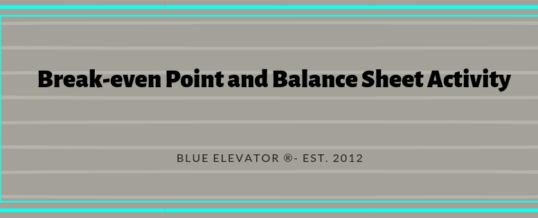
Break-Even Point and Balance Sheet Activity
Your Break-Even Point and your Balance Sheet activity are inter-related.
Thus far, we’ve covered that when you are working on your Break-Even Model (e.g., BE Model), you will need to consider the following various factors:
P & L Activity
So far, you should have identified all of the P & L (Profit & Loss) based expenses. If you have done this thoroughly and completely, you should have a list of vendors. And, for these vendors, you should have the related expenditures that comprise what you would pay them in a given year (e.g., 12 months). You will have calculated these on a monthly basis, as well.
For example:
Let’s say you pay rent to ACME Corp. in the amount of $20,000/month. And, at the end of the year, you pay them some NNN expenses totalling $12,600. This is a total of $252,600 (e.g., $20,000 x 12 + $12,600).
Your monthly total for the BE Model is then $21,050 (e.g., $252,600 / 12).
Additionally, remember that your P & L Revenue accounts and your Cost of Goods Sold accounts are “covered” as part of calculating Gross Margin.
Next, you will need to cover some of the elusive Balance Sheet accounts that affect your Break-Even Point.
Balance Sheet Activity
Similar to what you did in the P & L, you will now need to go through each of the Balance Sheet accounts.
Now, I will try to avoid burdening you with a bunch of technical accounting speak. But, you probably only need to look at certain accounts.
Note: If the Balance Sheet account is related to information you would have uncovered in the P & L, then you have already addressed it.
Therefore, we only need to identify Balance Sheet accounts that have activity that DID NOT get picked up in the P & L.
Balance Sheet Accounts — Typically Not Involved
Generally, you will not need to look through a majority of the Balance Sheet accounts. Cash, Accounts Receivable, Accounts Payable, etc. generally have activity covered in the P & L.
Balance Sheet Accounts — Typically Involved
On the other hand, you will need to identify certain Balance Sheet accounts that you need to consider.
- Fixed Assets. Will you need to acquire and/or dispose of certain assets?
- Notes Payable. Typically, an organization may have short-term and long-term debt commitments. The servicing of these notes affect cash-flow, obviously. But they don’t typically show up in the P & L. Next, you can identify all of the payments required in order to stay current on debt servicing. Then, calculate what this looks like on a monthly basis.
- Owner’s Distributions. It is not uncommon for closely-held entities to make periodic or recurring payments to owners or executives. This may be in lieu of payroll. You may need to make these payments to satisfy the owner’s or organization’s tax obligations. If you are required to make these payments, then add them to your BE Model.
Balance Sheet Accounts — Completeness
The above list of accounts is not necessarily an exclusive list. They key is to ask yourself two questions when you go through each Balance Sheet account:
- Does the account have activity NOT identified in the P & L?
- Is the activity required in order to support the ongoing operation of the business?
If you answered “yes” to both, you need to add it to your BE Model.
All Together Now
Now, simply create a list of ALL vendors and obligations.
You should have totals for both the P & L activity and the Balance Sheet activity.
When you aggregate these, you should have the total monthly “nut” you need to crack in order to stay in business.
Next Steps
When you’re ready, click the link to read the next article: Calculating Your Break-Even Point.
Also, contact us if you have any questions.
APR

About the Author:
Ken Moll is the Principal and Founder of Blue Elevator®. With professional experience spanning four decades, Ken has a breadth of foundational business knowledge rarely found – making him part of an elite class of professionals. Ken's passion is helping clients of Blue Elevator® get their “business to the next level™.”